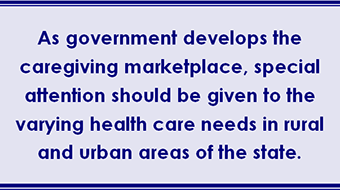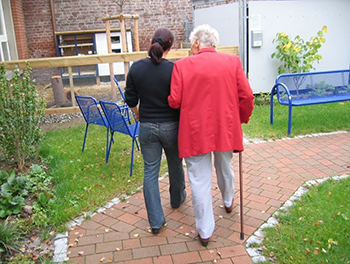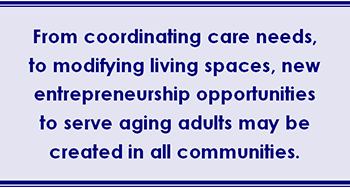You can also view this newsletter as a PDF.

Aging with Dignity:
Building California’s Silver Economy
The generation literally labeled for the population expansion their births produced – baby boomers – are heading into their elder years with the potential to live longer than their predecessors. By 2035, the number of people in the U.S. over age 65 will outnumber the population under age 18 for the first time. According to projections by the Governor’s Department of Finance, the percentage of Californians over age 60 will double from 2017 to 2057 – data that compelled the state’s new governor to call for a master plan on aging.
Often referred to as the silver tsunami, the growing number of older adults has brought focused attention to the ills of aging: heightened poverty risk, decreased mobility, increased isolation, and chronic health care needs. Tsunamis often are triggered by an earthquake or volcanic eruption and can cause severe damage to property and endanger human lives. The increase in our senior population need not have the same damaging effect and instead could be positively impactful. The challenges of aging can be balanced with the opportunities aging presents, enhancing the silver economy across multiple sectors.
Aging in Place
The U. S. Centers for Disease Control defines aging in place as “the ability to live in one’s own home and community safely, independently, and comfortably, regardless of age, income, or ability level.” While surveys consistently show an overwhelming majority of older adults prefer to age in place, lesser numbers are confident about their ability to do so. What can policymakers do to increase aging-in-place opportunities?
California is poised to build on two successful programs. In-Home Supportive Services (IHSS) workers provide personal care and domestic services to aged, blind, or people with disabilities who live in their own homes; while Programs of All-Inclusive Care for the Elderly (PACE) coordinates and provides all needed preventive, primary, acute, and long-term care services so older adults can continue to live in the community.
 Valuing the Caregiving Workforce
Valuing the Caregiving Workforce
The Public Policy Institute of California notes the state’s caregiving labor force doubled between 2006 and 2016. However, to support all individuals with self-care limitations, the state will need 600,000 additional home care workers by 2030. The U.S. Bureau of Labor Statistics anticipates the need for home health and personal care aides to increase by 41 percent in the next 10 years. The potential effects of this growing need are significant with respect to the economic toll on caregivers, families, and society. Nine out of 10 unpaid caregivers of adults age 65 and older are providing care for an aging relative, affecting their ability to participate fully in the workforce; and the average annual wage for a personal care worker is $23,000, with 20 percent of these workers living below the federal poverty line.
However, technological innovation, its disruptive impact on some job sectors, and a shortfall of qualified caregivers can converge to create well-paying health care jobs. Technology can support California caregivers who, in turn, can supply the irreplaceable elements of effective caregiving – empathy and human touch.
Policymakers have a unique opportunity to address the increasing need for caregivers to meet demand. For patients and families, the state should remove barriers for individuals who desire to safely age in place with dignity. For families, the state should ensure there is a transparent market of qualified caregivers. For caregivers, the state can facilitate a pathway for professionals to access training, emergent technologies, quality employment, and upward mobility. Policymakers should focus on two objectives:
- Promote affordable access to training and education for caregiving jobs.
- Ensure access to quality care is equitable by removing barriers to training and education.
Formalizing training. Training requirements for caregivers vary depending on the classification, and certification or registration requirements are spread across multiple state government entities. The state can provide incentives for completing training requirements (e.g., loan forgiveness, tax credits), subsidize training, and continue to strengthen the pipeline from community colleges to emerging health care sectors. Existing programs can form the basis of the pipeline of skilled caregivers, such as expanding IHSS certification and applying the model for paid apprenticeship training in the construction trades to the home care industry. In developing the caregiving workforce, efforts should target displaced workers and those newly entering the workforce, especially in communities underrepresented in medical professions.
To further attract and train caregivers, the state can create a new series of job classifications with certifications as workers move up the career ladder. These graduated classifications would allow added authority to complete certain care procedures with specialized training for patients with dementia, disabilities, and other special needs, based on training programs currently offered in the private sector. As proposed by the California Future Health Workforce Commission, this effort would attract new “universal home care workers” with increasing levels of responsibility in a clear path for advancement. Graduates could help fill the broader workforce gaps, moving into more advanced health care jobs such as nursing.
 In addition to creating pathways that support higher wages, government also can support systems that increase access to traditional benefits in the evolving economy. California already has established programs for basic health insurance (via Medi-Cal) and retirement savings (via CalSavers). Other benefits are more elusive. Like the trade guilds or labor unions, centralization allows for economies of scale and greater leverage for rate negotiation. As independent caregivers work for multiple families, benefits should be transferable across employers. An Aspen Institute proposal suggests state governments serve as an employer to administer workers’ compensation and unemployment insurance through a consumer surcharge on goods and services. New York City centralizes benefits funded by a charge on taxi and ride-sharing apps. The Care.com app offers built-in workers’ compensation contributions by family employers.
In addition to creating pathways that support higher wages, government also can support systems that increase access to traditional benefits in the evolving economy. California already has established programs for basic health insurance (via Medi-Cal) and retirement savings (via CalSavers). Other benefits are more elusive. Like the trade guilds or labor unions, centralization allows for economies of scale and greater leverage for rate negotiation. As independent caregivers work for multiple families, benefits should be transferable across employers. An Aspen Institute proposal suggests state governments serve as an employer to administer workers’ compensation and unemployment insurance through a consumer surcharge on goods and services. New York City centralizes benefits funded by a charge on taxi and ride-sharing apps. The Care.com app offers built-in workers’ compensation contributions by family employers.
Increasing access. Beyond a baseline of requirements for professional certification, limited and inconsistent information is available to families seeking caregivers. In conjunction with developing the workforce, policymakers can coordinate a transparent caregiving marketplace.
The state should identify universal standards (aside from the strict accreditations for certified nursing assistants and registered nurses) and create an online platform for both caregivers and families. As caregivers complete trainings, recognition badges representing the new skills and milestones could be added to caregiver profiles. As families experience outstanding caregiving services, they can support quality assurance by publicly sharing that information.
A single, robust online interface also could enable real-time communication, recruitment, and oversight for the network of health professionals. While some apps currently help match families with caregivers, the state can integrate metrics to provide families with more information. A state entity, such as the Department of Aging, can centralize all of the relevant caregiver information in one interface, rather than leaving families to navigate registries across several entities. A similar model currently helps parents find child care services.
As government develops the caregiving marketplace, special attention should be given to the varying health care needs in rural and urban areas across the state. Efforts should uplift the strengths of each region’s anchor institutions to develop the local and regional capacity to address caregiver demands for aging in place: hospitals and health care facilities, community colleges and state universities, labor unions, workforce investment boards, major businesses, local governments, and community-based organizations. Existing community leaders and partnerships are integral to this work, as is the sharing of best practices.
Government also can promote equitable access to quality services with broad deployment of technology. Technology has tremendous potential to improve the ability of seniors to age comfortably and safely in place. However, adequate infrastructure is critical for the deployment of new technologies. Even in 2019, geographic, economic, and political obstacles have delayed universal access to reliable and affordable high-speed internet.
In 1996, California passed one of the nation’s first state telehealth laws, yet policymakers have made few regulatory changes to keep up with technological innovation since then. For elder care, telehealth can facilitate remote consultations, medical diagnoses, monitoring of vital signs, and more. Policymakers must commit to investing in technology infrastructure, which will facilitate more equitable deployment of new technological innovations such as artificial intelligence and robotics.
 Supporting a Wellness Marketplace
Supporting a Wellness Marketplace
It is critical to place more emphasis on caregiving in order to expand opportunities for aging in place. However, shifting the focus to wellness and prevention rather than reacting to deficiencies and disease can enhance quality of life at all stages. To complement caregiver value and related marketplace development, a wellness marketplace can cross many sectors.
Investing in the wellness and support of caregivers. There is much discussion about the need to develop caregivers, and the role caregivers play in enabling family members to work cannot be understated. Caregiver wellness and support programs beyond training and education may include care-coordination services, strategies for working with diverse patient populations, and more robust caregiver networks that provide transportation, emotional support, and respite services.
Focusing on housing and community. Aging in place elevates the importance of making the home an appropriate environment. Modifications often are necessary to enhance safety and mobility, and perhaps provide for co-living or multigenerational arrangements. Local governments’ strategies for developing smart communities can take into account the growing number of older adults when considering issues such as transportation, outdoor space, public services, health care and nutrition, information services, social engagement, and civic participation.
Further complicating the challenge is housing instability. Increasing rents have led to a growing number of households spending a majority of their income on rent. This has hit aging households especially hard, as they often are reliant on fixed incomes. In the U.S., half of people experiencing homelessness are older than 50, and nearly half of those became homeless for the first time after turning 50. Homelessness further exacerbates the health care needs of older adults by increasing physical and mental stress. To ensure seniors have access to available resources to prevent homelessness, California must continue subsidizing the development of affordable housing with supportive services for seniors. More broadly, policymakers must address the affordability challenges created by the limited supply of housing.
Deploying new technologies. The new technologies that increasingly facilitate health and wellness at all stages of life must be incorporated into the caregiving experience. For example, falls are the leading cause of injuries among older adults; caregivers and prevention technologies can help with in-home assessments of medications and potential hazards as well as fall detection. Medication tracking may be accomplished through internet-enabled dispensers. Patient and worker safety can be improved with robotics that assist with physical and occupational therapies and activities of daily living. Robotics is being explored for therapies for patients with dementia, and there are promising developments with artificial intelligence for mood assessments.
Equitable deployment of new technologies without regard to geography and income must be encouraged while carefully weighing privacy concerns.
Rethinking insurance. Long-term care insurance can provide peace of mind when planning for aging in place, assisted living, skilled nursing, and other care in older adulthood. However, longer life expectancies, healthier older adults, and rising premiums have made traditional long-term care insurance policies less appealing. For many without long-term care insurance, the costs of care fall to family members. More recent models present additional options that may better fit the diverse care needs of older adults.
 Alternative products include life insurance policies with long-term care riders and short-term care insurance. Income products tailored to long-term care needs include annuities, annuities with long-term care riders, and deferred annuities. Of course, there are advantages and disadvantages associated with each product, and state regulatory oversight can provide meaningful consumer protection.
Alternative products include life insurance policies with long-term care riders and short-term care insurance. Income products tailored to long-term care needs include annuities, annuities with long-term care riders, and deferred annuities. Of course, there are advantages and disadvantages associated with each product, and state regulatory oversight can provide meaningful consumer protection.
Respecting older workers. Adults are living longer and maintaining good health. Factors such as cost-of-living increases and the need for social participation are causing many to stay in the workforce longer. For the first time in history, four generations are represented in the U.S. workforce. Older adult workers should be valued and respected, and workplace diversity considerations must include the needs of aging people. Inclusive workplaces respect a variety of talents and foster continuous learning. Observers note younger workers may be more tech-savvy and risk-taking, while older adult workers bring cross-sector experience.
Multigenerational opportunities can help to inform future work, health care, housing, and mobility policies that can be more responsive to diverse needs, flexible to meet limited resources, and conducive to redefining healthy and sustainable communities.
Growing entrepreneurship opportunities. From coordinating care needs, supporting caregivers, and modifying living spaces, to incorporating new technologies and navigating options for long-term care coverage, new entrepreneurship opportunities to serve aging adults may be created in all communities. Small businesses engaged in services for older people can fuel local and regional economies. Reimagining how to serve the needs of older adults can refresh the role of anchor institutions: educational institutions, hospitals and health care facilities, and even supermarkets whose expanded focus could be on health and nutrition.
The private sector is pivotal to attaining triple-bottom-line solutions and strategies to meet the needs of our older population: strategies that are equitable with respect to access and opportunity; prosperity with respect to attracting capital and the deployment of technology to create jobs; and sustainability and resiliency in the capacity of local communities.
From Silver Tsunami to Silver Economy
Widely viewed around the globe as the home of technological innovation, California also can be the home for human innovation, as we tackle the issues to ensure California fosters an aging-with-dignity environment, regardless of geography or income. Affordability. Access to quality care. Support for caregivers (especially family). Choice of settings in which to live and work. All of these are critical to creating an economy that supports – and, in turn, is supported by – older adults.